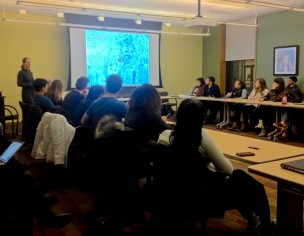WSA meeting marks first phase in campus improvement project.
The University has formed a partnership with Sasaki, a Watertown, Mass.-based consulting firm, to begin the first phase of a campus improvement project expected to last between ten and fifteen years.
Principal architects Katia Lucic and Bryan Irwin attended the semester’s first Wesleyan Student Assembly (WSA) meeting on Sunday, Jan. 25. Campus planner Linda Eastley—formerly of Sasaki and now heading her own firm—was also in attendance and served as the primary presenter of the plan.
“What we’re up to is not really a true master plan,” Irwin said. “This is like the precursor for the actual master plan. What we want to do before we launch into a comprehensive master plan that looks into a whole bunch of issues simultaneously, we want to just focus on teaching and learning on campus. How does it happen? What works well? What doesn’t work well?”
To answer these questions, this initial meeting primarily consisted of Eastley and Sasaki representatives asking students to name their favorite aspects of the campus, as well as what they felt that the campus lacked. Responses were guided by three focal questions: What sets Wesleyan apart from other institutions? How important is the classroom and lab experience to the Wesleyan identity? What spaces inspire you to learn?
Each member of the WSA was given the opportunity to respond to one of the questions (due to time constraints) if they so chose, and though a variety of students took advantage of the opportunity to give their input, the answers focused around a small number of locations and concepts.
On the former, a common theme was multipurpose spaces. A general consensus on the versatility and comfort of the Allbritton Center for the Study of Public Life grew as many lauded its variety of uses.
“It’s beautiful, aesthetically from the outside, but also inside there’s a great usage of space,” Kate Cullen ’16, a former WSA member, said. “There are a lot of really beautiful classrooms; there’s a lot of natural light. Overall as a building, you can use it for so many different things, and it’s so aesthetically pleasing and comfortable.”
Anna Pezanoski-Cohen ’17 concurred.
“[Allbritton] is my favorite space on campus,” she said. “Room 311, at the top of Allbritton, is where you should go if you want to see an awesome space. It has amazing views. You really feel like a part of nature there.”
Conversely, students and consultants alike agreed that there is a need for more consistently available common space for students to congregate. Usdan’s mealtime traffic and lack of large meeting spaces were mentioned, the latter discussed at length.
Other areas of particular interests included the top of Foss Hill, senior housing, and the open space behind college row.
Eastley asked students many follow-up questions in order to have the audience think more deeply about their current opportunities as well as their needs. She encouraged students to evaluate the aspects of the campus, both physical and social, that they value most. In one instance, she asked a commenter what he would say to the University’s Board of Trustees if he were asked to make a case.
In addition to the structures on campus, Sasaki will examine the landscape and the ways in which students use it.
“For me, what’s quickly becoming clear about both the buildings and the landscape is that there’s a sense of informality that everyone talks about, which I find very interesting,” Irwin said.
Though Eastley stated that further investigation into the landscape and its use must be conducted, she did come away with a first impression.
“One observation is that you have almost a moat around your campus,” she said. “You’ve got your historic row of buildings, and on the opposite side of where the activity is, you have this green moat, [which] students don’t really use. It sets you apart from the town, and kind of creates that psychological distance, but on the side where you might need the greatest number of spaces, you don’t have them.”
Sasaki is interested in hearing the opinions of the entire student body on how best to move forward with creating a plan to use the campus to its full potential. Its website for the project includes an interactive survey as well as a frequently checked comment board. The survey will remain open until Feb. 3, and the results will be available by May. The project will conclude in early June.
-
Ron Medley
